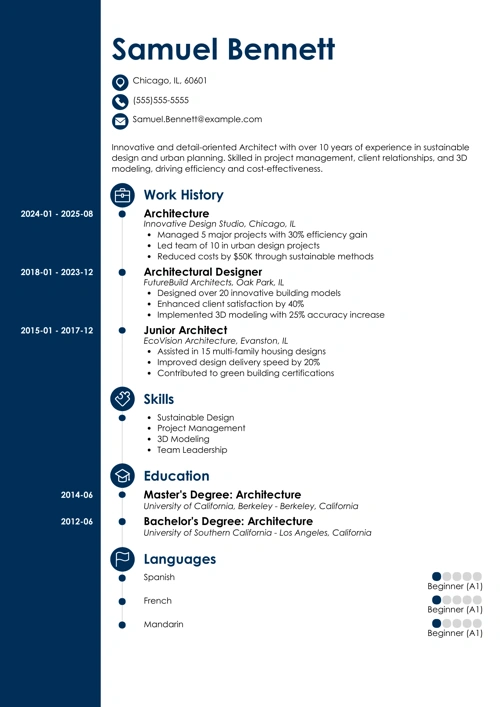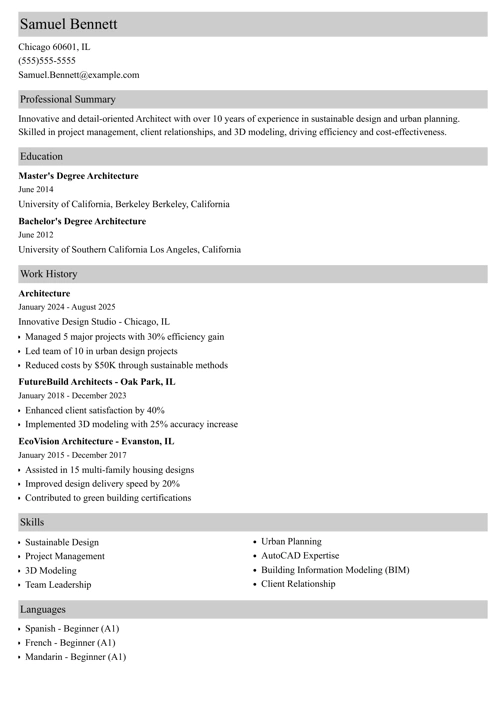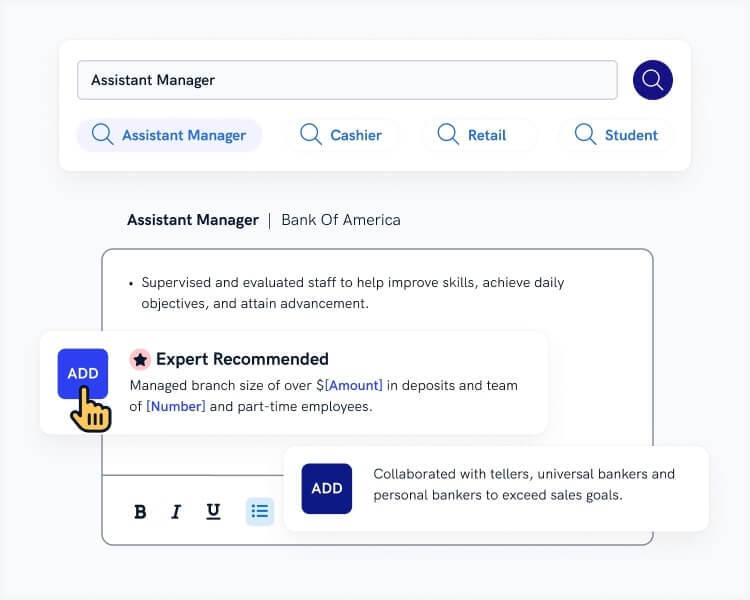If your architecture career were a building, your resume would be its foundation. And we all know a strong base is essential for any lasting structure. Fear not, future Frank Gehry, we've got the concrete solutions to elevate your resume to skyscraper heights.
With our examples and templates, you'll craft an architecture resume to make hiring managers think they've discovered Atlantis. Get ready to construct a career foundation rivaling China's Great Wall!
This guide will show you:
- An architect resume example better than 9 out of 10 other resumes.
- How to write an architecture resume example that will land more interviews.
- Tips and examples of how to put skills and achievements on an architecture resume.
- How to describe your experience on a resume for architecture jobs to get what you want.
Here's a sample resume for an architect made using our resume builder.
Want to save time and have your resume ready in 5 minutes? Try our resume builder. It’s fast and easy to use. Plus, you’ll get ready-made content to add with one click. See 20+ resume templates and create your resume here.
Sample resume made with our builder—See more resume examples here.
Our architecture resume example looks great, but you want to see more samples? Visit our dedicated guides:
- Civil Engineering Resume
- Construction Resume
- Landscaping Resume
- HVAC Resume
- Interior Design Resume
- Landscape Architecture Resume
- Systems Engineer Resume
- Maintenance Resume
- Solution Architect Resume
- More Example Resumes for 500+ Jobs
Architecture Resume Example
Samuel Bennett
Architect
123-456-7890
samuelbennett@email.com
linkedin.com/in/samuel.bennett
Summary
Dedicated Architect with over 10 years of experience. Seeking to help ArchiCraft Innovations in their mission to revolutionize urban landscapes by leveraging strong expertise in creating aesthetically pleasing and functional spaces. Renowned for designing the award-winning "Urban Sphere" residential complex.
Experience
Architect
DesignSphere Architects, Mobile, AL
June 2010–Present
Key Qualifications & Responsibilities
- Creating and executing project work plans and revising them appropriately to meet changing needs and requirements.
- Conceptualizing and designing buildings and structures that are visually powerful and intellectually elegant.
- Leading a team of five architects on large architectural projects and always meeting deadlines.
- Working closely with the construction team to ensure the project stays within budget.
Key Achievement:
- Designed the award-winning "Urban Sphere" residential complex.
Junior Architect
BlueprintBuilders Design, Mobile, AL
July 2005–May 2010
Key Qualifications & Responsibilities
- Assisted in the coordination of plans and designs.
- Prepared scaled drawings and contract documents for building contractors.
- Helped in the architectural assessment and survey of sites.
Key Achievement:
- Played a pivotal role in the "GreenVine" office project, which won the Architectural Design Association award.
Education
Master of Architecture
University of Alabama, Tuscaloosa, AL
August 2000–May 2005
Skills
- Creativity and artistic ability
- Visualization
- Strong communication and presentation skills
- Detail-oriented
- AutoCAD
- Revit
- Adobe Creative Suite
Certifications
- Licensed Architect (AL), American Institute of Architects, 2009
Awards
- 2017, Architect Design Award, American Institute of Architects
Memberships
Member of the American Institute of Architects since 2008
Languages
- English—Native proficiency
- Spanish—Intermediate proficiency
Interests
- Sketching cityscapes.
- Heritage building restoration volunteering.
That's how to create a job-winning resume for architecture:
1. Choose the Best Format for an Architecture Resume
Meet the hiring manager at the biggest, best architecture firm on the planet. Her name's Jan. Please, no, "Marsha, Marsha, Marsha" jokes. She's buried beneath enough architectural resumes to wallpaper One World Trade Center. If you could meet her – if she only knew what you can do, she'd hire you in a millisecond.
The trouble is, your architectural resume format hides your talents like underground parking.
Let me show you what I mean.
First, the two-page resume screams TL/DR (Too Long, Didn't Read).
Next, don't resort to over-the-top gimmicky resumes. Creative resume designs on ceiling tiles or building models aren't up to code.
Use a trusted resume design like reverse-chronological. It's the best architecture resume format because it puts your biggest wins up front.
That's key, since recruiters spend just six seconds with each resume, according to our HR statistics report. So stick to the classic US resume format.
Use clean fonts, big headings, one inch resume margins, and negative space.
Finally, save your architecture resume as a PDF. Architect resume PDFs preserve their formatting in transit. MS Word or .doc resumes can fall into disrepair between machines.
Pro Tip: Does the firm accept resumes for architects as PDFs? Some don't. Check the job offer.
Don't want your resume design set in stone just yet? Check out other formats for your best architectural resume: "3 Resume Formats: How to Choose the Best One [Examples]"
2. Write an Architect Resume Summary or Resume Objective
Remember, the hiring manager will spend just six seconds with your architecture resume. That's just enough to keep her reading. Do that with a resume summary or a resume objective.
A resume summary convinces by showing your experience. Use it if you've got skyscrapers-full.
A resume objective shares your passion. It's a snapshot of your laser-leveled goal.
Take a look at what I mean. Check out these two very different design architect resume samples.
| wrong |
|---|
Registered architect skilled in CAD design, Revit, building codes, and business knowledge. Seeking a position in design for a high-level architecture firm. |
What's wrong with that? Nothing, on its own. But, like one McMansion in a massive development, it's too much like all the rest. Now what if we add some measurable achievements?
Architect Resume Summary Example
| right |
|---|
Highly creative AIA registered architect with 9+ years experience. Seeking position as design architect with AECOM. Designed 25+ multi-million dollar jobs for DDG, at 30% less cost than competitors, with 15% less rework than colleagues. Received 15 client commendations. |
Wow. Now you look like Mike Brady with a Pritzker Prize.
Making a resume with our builder is incredibly simple. Follow our step-by-step guide, use ready-made content tailored to your job and have a resume ready in minutes.
When you’re done, Zety’s resume builder will score your resume and our resume checker will tell you exactly how to make it better.
But what if you're writing an architect resume for an internship?
How to Write The Best Resume Objective for an Architecture Student Resume
Don't have experience? Think your intern architecture resume will look like a new AutoCAD document Write an objective statement. They're for architecture student resumes or internships.
| wrong |
|---|
Passionate architecture student, skilled in CAD design and budgeting. Seeking an internship with a fast-paced design and engineering firm. No experience yet but eager to get started. |
That's not awful, but it'll ultimately fail to please, like that Elephant Building in Bangkok. But watch what happens if we add accomplishments:
Objective for an Architect Student Resume
| right |
|---|
Enthusiastic architecture student, excelled in CAD design coursework. Won second place in the Better Philadelphia Architecture Competition for inexpensive design. Created 3D models for a hotel made of shipping containers. |
Nice. You might be the next Frank Gehry. But how did an architecture student get that kind of experience for a resume?
She did it by digging into her past, and taking a couple proactive steps. I'll show you how in a minute.
Pro Tip: If you're licensed, you took 7 exams and 1,200 internship hours. That's impressive, so show it in your architect resume objective statement. And for experienced candidates, a statement of qualifications is a good alternative type of personal profile.
For more examples, see the architecture resume template at the top. Plus, check out our guides: How To Write A Resume Summary: 21 Best Examples You Will See AND +20 Resume Objective Examples - Use Them on Your Resume (Tips)
3. Describe Your Experience on Your Architect Resume
Does the way you show experience matter on an architecture resume? Only as much as structural supports. So, let me show you how to list experience that gets attention like Zaha Hadid.
List your most recent job first. Add 5-6 bullet points that mix duties and accomplishments.
Here's the magic: Fit those bullet points to the job description.
Picture a job that values design, big projects, high-quality, and cost-savings.
Architect Resume Examples of Responsibilities
| right |
|---|
Registered Architect (Design, Production) Doane Daviau Giguere 2012 - 2017
|
Wow. Maybe you didn't design the Lotus Temple, but I'll bet five years of picking out carpet swatches that you'll get the interview.
It works so much better than the next of our architecture resume examples.
| wrong |
|---|
Registered Architect (Design, Production) Doane Daviau Giguere 2012 - 2017
|
There's nothing wrong with that. There's nothing wrong with tract housing, either. But neither draws the eye.
Next, what if you're writing an architecture student CV?
How to Write an Architecture Student Resume with No Experience
Up your game on a junior architectural resume for interns by listing:
- Freelance projects
- Articles you've written
- Competitions or awards you've won
- Anything else at all that sounds like an achievement.
Look how that's done in these two entry-level architecture resume samples:
| wrong |
|---|
Architect Experience: No experience yet, since I still have yet to land my internship. Other Experience
|
Just awful, right? Like a modular home, but without the charm. Now look what happens when we add details:
Architecture Student Resume for an Internship (Sample)
| right |
|---|
Freelance Architect 2016 - 2017
|
Wow, right? You might just be the next I.M. Pei or Norman Foster. But the secret is, it didn't take much time to do all this.
The point? With a little thinking, even an architecture student resume can turn some heads. Look online for freelance or volunteer architect jobs. Attend a conference or enter a competition. Anything that shows your dedication looks great on a resume for architects.
Pro Tip: Already did your internship? List it as experience, like any job. Check our great architect resume template up top for an example.
Need more tips to put your architecture resume in the Gensler category? See this guide: "How to Put Achievements on a Resume - Complete Guide (+30 Examples)"
4. Highlight Your Education on an Architect Resume
Oh-oh.
Our hiring manager, Jan? She just stopped reading your great architecture resume. Why? Because your education confused her. The path to a career in architecture is incredibly complex.
Your architectural resume can't be.
Break ground with the basics:
- College Name(s) and Location(s).
- Years in School.
- Degree.
List your bachelor's degree, and master's degree if you have one.
Then tie your bullet points to the job offer, like this:
Imagine a job that values CAD design, modeling, and working with new materials.
Architect Resume Examples of Education
| wrong |
|---|
2006 - 2008, California College of the Arts, Masters in Architecture Received Master's Degree GPA 3.3 |
That doesn't fit the job offer. In fact, it's a pretty bad resume example. It's like they asked for the Sydney Opera House and got a Walmart Supercenter. Now look at this next architecture resume sample:
| right |
|---|
M. Arch., California College of the Arts 2015 - 2017
B. Arch., Woodbury University 2011 - 2015
|
Pow. Tongue-in-groove, right? Everything fits. It just takes attention to the job offer, and a little shopping in your past.
Pro Tip: Should you show your GPA or nix it? If it's a proud achievement, celebrate it. Otherwise, encase it in 500 feet of concrete.
Want to design resumes for architecture that pop out like the Guggenheim? See this guide: "How to Put Your Education on a Resume [Tips & Examples]"
5. Highlight Your Skills on a Resume for Architecture
"Let's definitely interview this one."
Your architecture resume can make the hiring manager say the words above.
How?
By being different.
Here's what everybody does:
| wrong |
|---|
Skills: AutoCAD, CAD, Revit, Drafting, Estimating, Legal Skills, New Construction, Project Management, Renovation, Scheduling, Requirements Building, Model Making, Budgeting, Finance, Kitchen Sink Installation... |
You earned those skills, so you want to show them off. But to a manager, it's as impressive as a trailer home.
So, list just the skills you see in the job offer, plus a few.
Then, prove them in your bullet points. Check out the next of our top architect resume examples.
Skills in the job offer: Adherence to Budgets, Rework Reduction, New Business Generation.
Skills in your architecture resume skills list: The above plus Communication and On-Time Delivery.
| right |
|---|
Experience
|
Paydirt. You list the right skills, then you prove them. The hiring manager just stopped fiddling with her scale model of Falling Water and reached for the phone.
List of Skills to Put on an Architect Resume
Here's a list of common architecture resume skills.
Add to them by trolling job offers online.
Architecture Resume Skills
| Soft Skills | Hard Skills | Technical Skills |
| Communication | Engineering | AutoCAD |
| Creative Thinking | Math | CAD |
| Critical Thinking | Design | Drafting |
| Problem Solving Skills | Computer Skills | Revit |
| Listetning | Building Codes | Estimating |
| Detail Oriented | Business Knowledge | Legal |
| Decision Making | Specifications | New Construction |
| Strategic Thinking | Model Making | Project Management |
| Perceptiveness | Budgeting | Renovation |
| Collaboration | Fianance | Scheduling |
Follow the plan above, and your architect resume will make you look like the next Santiago Calatrava. Also, remember to show examples of your skills in the experience, education, and "other" sections of your architecture resume.
We’ve analyzed over 11 million resumes created using our builder, and we’ve discovered that:
- Architects usually list 7 skills on their resumes.
- The most common skills for Architects include interior design, technical architecture design, problem-solving abilities, analytical thinking, and Revit.
- Resumes for Architects are, on average, 2.8 pages long.
Want to elevate your skills section? Follow the professional architectural resume template up top. Also, see our guide: "+30 Best Examples of What Skills to Put on a Resume (Proven Tips)"
6. Add Certifications and Licenses to Your Architecture Resume
You only had to pass seven ARE exams to get your architect's license.
So it doesn't matter how you show it on your architecture resume. Right?
Of course that isn't true.
You got your 5-7 year degree, completed a 2-4 year internship, and passed 7 rigorous tests. That alone should blow the modular-arches-patterned socks off any hiring manager.
So, put your license in a special "Licenses" section, like this:
Licenses
- Registered Architect, American Institute of Architects (AIA)
- Certified Professional Building Designer, NCBDC
Also, put AIA after your name, and add it to your work experience. It'll show the manager you're qualified at a glance, from anywhere on your architect resume. Anything less would be like covering St. Paul's Cathedral with McDonald's logos.
Writing a landscape architect resume?
Certification
- CLARB Certified Landscape Architect
Pro Tip: Got 40 floors of certifications? Use the few that really matter for this job offer. A resume for architecture is not a laundry list.
Now you know how to add certifications and licences to architecture resumes. Need more advice to help build out a resume for an architect? See this guide: “What To Put On A Resume To Make It Perfect [Tips & Examples]”
7. Add Other Sections for an Effective Architect Resume
Picture a hiring manager's desk. On it, near her 2B or Not 2B coffee mug, sit two piles of architecture resumes. One is 250 deep. That's the rejects pile. The other has just 50 resumes. That's the "second look" stack. Your resume's in there.
The problem?
Everyone in pile #2 has similar experience and skills. How can you set yourself apart?
With dedicated "other" sections that show your passion and commitment.
Add anything that shows you as the Mackey Mitchell type.
Architect Resume Sample "Other" Sections
Competitions
- 2nd Place, Tomorrows Challenges in Today's Buildings Competition, 2016.
- 3rd Place, Open International Contest for Standard Housing, 2015.
Conferences
- AIA Conference 2017
- WIDA 2016
Publications
- "Function vs Kitsch," Dezeen.com, 2014.
- "How Tech is Changing Architecture," Domestic Space, 2016.
That gets attention like the Dancing House in Prague.
Awards, exhibitions, resume projects, conferences, language skills, publications, and professional association memberships all make excellent detail on an architecture resume.
Should You Have an Online Portfolio?
How can a single sheet of paper convey your talent?
It can't.
So, have a pro architect resume portfolio.
A portfolio resume for architecture shows the depth and color missing in a resume. Architecture resumes and portfolios go hand in hand.
If you're a design architect, fill it with designs and images of finished structures.
Are you a production architect? Use pictures of your work. Still a student? Concept drawings and pics of models will work great.
Pro Tip: This advice works just as well on a landscape architecture resume or an architectural designer resume. Read the offer, then customize.
Need more meat for great architect resume "other" sections? Use this guide: "+20 Best Examples of Hobbies & Interests To Put on a Resume (5 Tips)"
8. Attach a Cover Letter to Your Architecture Resume
Here's the most common myth about cover letters: "Nobody reads architect cover letters." Said every architect who thinks they're hard to write.
The truth is, 40% of hiring managers consider them essential. Not sure which kind you're dealing with? Write a cover letter for your architecture resume.
Here's how:
Make it personal. Use the hiring manager's name. Include a fact or two about the company. Make it useful. Show metrics that fit the job requirements.
Example:
Dear Jeremy,
I loved Doane and Daviau's design for the new Crosslake Junction Health Clinic. Your press release highlights your commitment to lowering costs while raising quality. As a production architect at Peabody & Apicella, I consistently delivered projects 15% below budget, with frequent client commendations for design.
End it with a call to action like, "I'd welcome the opportunity to talk more with you about your needs." You can use this same strategy in an interior design resume.
Pro Tip: Don't forget to follow up. Maybe you got rejected or the manager forgot. Either way, a follow-up gives your architect cover letter and resume a second chance.
Plus, a great cover letter that matches your resume will give you an advantage over other candidates. You can write it in our cover letter builder here. Here's what it may look like:
See more cover letter templates and start writing.
Want a concrete example for your good architecture CV? See this guide: Architecture Cover Letter: Sample & Complete Guide [20+ Examples]
9. Add Contact Info to Your Resume
You're probably making a mistake with contact info on your architecture resume.
Of course you'll add:
- Full Name
- Updated Phone Number
- Professional Email Address
Like this:
Darcie Abimola, darcieabimola@gmail.com - 213-698-9195
But what about LinkedIn? Twitter? Or a personal portfolio resume site?
If other candidates add those and you don't, they'll grab the manager's interest while you fade into the masonry.
Pro Tip: Not sure what to put in your LinkedIn profile to give your architect resume it's best chance? See our guide on how to make a great LinkedIn profile.
Want more tips to help you write a professional resume for architecture? See this guide: "How to Make a Resume: A Step-by-Step Guide (+30 Examples)"
Key Takeaway
Even with good architect resume templates, drafting your own can be a challenge. Here's what you should do:
- Start with the job offer. Highlight skills and requirements. Then use them to customize your architect resume.
- Match the bullet points of your resume for architecture to the skills you highlighted.
- Add "other" sections to an architecture student resume. They'll prove you're stuffed to the rafters with passion and commitment.
- Don't forget to include a cover letter in your job application.
About Zety’s Editorial Process
This article has been reviewed by our editorial team to make sure it follows Zety's editorial guidelines. We’re committed to sharing our expertise and giving you trustworthy career advice tailored to your needs. High-quality content is what brings over 40 million readers to our site every year. But we don't stop there. Our team conducts original research to understand the job market better, and we pride ourselves on being quoted by top universities and prime media outlets from around the world.




